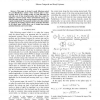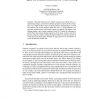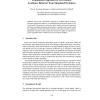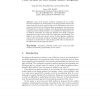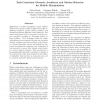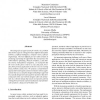132
click to vote
IJACTAICIT
2010
14 years 9 months ago
2010
In this work, a Modified Vector Field Histogram (MVFH) has been developed to improve path planning and obstacle avoidance for a wheeled driven mobile robot. It permits the detecti...
91
Voted
CDC
2009
IEEE
14 years 10 months ago
2009
IEEE
This paper is devoted to path following control for port-Hamiltonian systems whose desired path is timevarying. Most of the existing results on path following can only take care of...
108
Voted
DAGSTUHL
2003
15 years 1 months ago
2003
Abstract. This study illustrates how obstacle avoidance can emerge from a visual homing strategy, caused by the intrinsic geometric structure of the environment. An example is show...
103
Voted
ICANN
1997
Springer
15 years 4 months ago
1997
Springer
We present a minimalistic approach to establish obstacle avoidance and course stabilization behavior of a simulated flying autonomous agent in a 3D virtual world. The agent uses v...
88
Voted
AGENTS
1997
Springer
15 years 4 months ago
1997
Springer
Real-time obstacle avoidance and low-level navigation is a fundamental problem for autonomous animated creatures. Here we present an ethologically inspired approach to this proble...
106
Voted
SEAL
1998
Springer
15 years 4 months ago
1998
Springer
Most of the obstacle avoidance techniques do not consider the robot orientation or its nal angle at the target position. These techniques deal with the robot position only and are ...
ICRA
2002
IEEE
15 years 5 months ago
2002
IEEE
Dynamical systems theory is used here as a theoretical language and tool to design a distributed control archictecture that generates navigation in formation, integrated with obst...
77
Voted
ICRA
2002
IEEE
15 years 5 months ago
2002
IEEE
Applications in mobile manipulation require sophisticated motion execution skills to address issues like redundancy resolution, reactive obstacle avoidance, and transitioning betw...
ICRA
2003
IEEE
15 years 5 months ago
2003
IEEE
Abstract— In this paper, we present an approach to obstacle avoidance for a group of unmanned vehicles moving in formation. The goal of the group is to move through a partially u...
104
Voted
IAT
2003
IEEE
15 years 5 months ago
2003
IEEE
The design of a an agent system for robotics is a problem that involves aspects coming from many different disciplines (robotics, artificial intelligence, computer vision, softwa...

